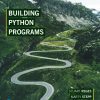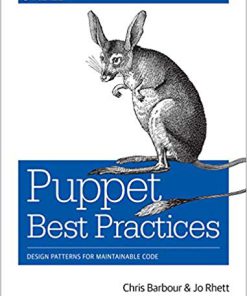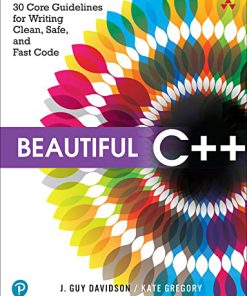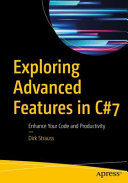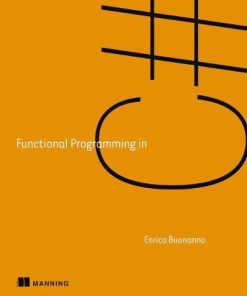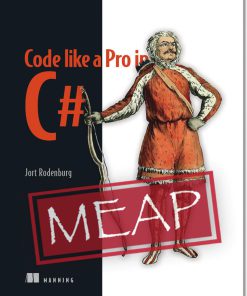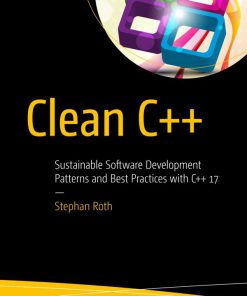Clean Code with C# Refactor your legacy C# code base and improve application performance using best practices 2nd Edition by Jason Alls 9781837632992 1837632995
$50.00 Original price was: $50.00.$25.00Current price is: $25.00.
Clean Code with C# Refactor your legacy C# code base and improve application performance using best practices 2nd Edition by Jason Alls – Ebook PDF Instant Download/Delivery: 9781837632992, 1837632995
Full download Clean Code with C# Refactor your legacy C# code base and improve application performance using best practices 2nd Edition after payment

Product details:
• ISBN 10:1837632995
• ISBN 13:9781837632992
• Author:Jason Alls
Traditionally associated with Windows desktop applications and game development, C# has expanded into web, cloud, and mobile development. However, despite its extensive coding features, professionals often encounter issues with efficiency, scalability, and maintainability due to poor code. Clean Code in C# guides you in identifying and resolving these problems using coding best practices. This book starts by comparing good and bad code to emphasize the importance of coding standards, principles, and methodologies. It then covers code reviews, unit testing, and test-driven development, and addresses cross-cutting concerns. As you advance through the chapters, you’ll discover programming best practices for objects, data structures, exception handling, and other aspects of writing C# computer programs. You’ll also explore API design and code quality enhancement tools, while studying examples of poor coding practices to understand what to avoid. By the end of this clean code book, you’ll have the developed the skills needed to apply industry-approved coding practices to write clean, readable, extendable, and maintainable C# code.
What you will learn
Master the art of writing evolvable and adaptable code
Implement the fail-pass-refactor methodology using a sample C# console application
Develop custom C# exceptions that provide meaningful information
Identify low-quality C# code in need of refactoring
Improve code performance using profiling and refactoring tools
Create efficient and bug-free code using functional programming techniques
Write cross-platform code using MAUI
Develop cloud-deployable microservices for versatile applications
Who this book is for
This coding book is for proficient C# developers, team leads, senior software engineers, and software architects who want to improve the efficiency of their legacy systems. A strong understanding of C# programming is assumed.
Clean Code with C# Refactor your legacy C# code base and improve application performance using best practices 2nd Table of contents:
What this book covers
To get the most out of this book
Download the example code files
Conventions used
Get in touch
Share Your Thoughts
Download a free PDF copy of this book
Chapter 1: Coding Standards and Principles in C#
Technical requirements
Good code versus bad code
The need for coding standards, principles, and methodologies
Coding standards
Coding principles
Coding methodologies
Summary
Questions
Further reading
Chapter 2: Code Review – Process and Importance
A brief introduction to GitHub
What is GitHub?
GitHub’s use within the code review process
Resources for learning
The code review process
Preparing code for review
Leading a code review
Issuing a pull request
Responding to a pull request
Effects of feedback on reviewees
Knowing what to review
The company’s coding guidelines and business requirement(s)
Naming conventions
Formatting
Testing
Documentation
Architectural guidelines and design patterns
Performance and security
Knowing when to send code for review
Providing and responding to review feedback
Providing feedback as a reviewer
Responding to feedback as a reviewee
Summary
Questions
Further reading
Chapter 3: Classes, Objects, and Data Structures
Technical requirements
Organizing classes
A class should have only one responsibility
Class organization
Commenting for documentation generation
Cohesion and coupling
Tight coupling
Low coupling
Low cohesion
High cohesion
Designing for change
Interface-oriented programming
Dependency injection and inversion of control
The Law of Demeter
A good and a bad example (chaining) of the Law of Demeter
Immutable objects and data structures
Using records to create immutable objects
Objects should hide data and expose methods
An example of encapsulation
Data structures should expose data and have no methods
The SOLID software methodology
SRP
Open/closed principle (OCP)
Liskov substitution principle (LSP)
Interface segregation principle (ISP)
Dependency inversion principle (DIP)
Summary
Questions
Further reading
Chapter 4: Writing Clean Functions
Technical requirements
Understanding the difference between OOP and FP
Explanation of the differences
Understanding why FP can lead to cleaner functions
Unclean methods and how they affect software
FP and clean methods
FP examples
Keeping methods small
Indenting code
Breaking out of loops
Avoiding duplication
Avoiding multiple parameters
Implementing the SRP
Handling exceptions in FP
Adding comments for readability
XML documentation comments
Inline comments
Variable declaration and memory management
Declaring variables close to their usage
Disposing of resources
Applying security in methods, especially in APIs
Input validation
Authentication and authorization
Protecting sensitive data
Summary
Questions
Further reading
Chapter 5: Exception Handling
Technical requirements
Overview of exception handling in C#
try-catch
try-catch-finally
Clean code exception-handling principles
SRP
OCP
DIP
Best practices for handling exceptions
Handling the TPL AggregateException exception
Use await with try-catch inside async methods
Flatten the exception hierarchy
Handle individual exceptions
Handle exceptions as they occur
Creating custom exceptions and when to use them
Avoiding common mistakes in exception handling
Testing exception handling
Unit testing exception handling
Integration testing exception handling
End-to-end testing exception handling
An employee management example of mocking and unit testing with correct exception handling
Summary
Questions
Further reading
Chapter 6: Unit Testing
Technical requirements
Understanding unit testing
Writing testable code
TDD
An example of using the AAA TDD pattern
Choosing a testing framework
Testing framework attribute differences
TDD using MSTest
TDD using NUnit
TDD using xUnit
Running tests in Visual Studio
Writing effective unit tests
Using code coverage analysis in Visual Studio 2022
Ensuring your unit tests themselves are correct
Using stubs in place of mocks
Mocking data
Integrating tests into the continuous integration and deployment (CI/CD) pipeline
Integrating tests into an Azure DevOps CI/CD pipeline
Problem tests
Summary
Questions
Further reading
Chapter 7: Designing and Developing APIs
Technical requirements
What is an API?
APIs help different consumers build loosely coupled applications
Idempotent and non-idempotent operations
HTTP verbs
Important API design topics you must consider
How can clean code help API design and development?
The API design process
API security risks and their mitigations
On-premises APIs versus cloud APIs
API development in C#
Web API security with OWASP
Importance of OWASP adherence in C# API development
Creating an OWASP-compliant API
Implementing OWASP-compliant two-factor authentication (2FA)
OpenID Connect (OIDC) and OAuth 2.0 (OAuth2)
Summary
Questions
Further reading
Chapter 8: Addressing Cross-Cutting Concerns
A definition of cross-cutting concerns
Importance and impact on software development
Common examples of cross-cutting concerns
Logging
Error handling and exception management
Caching
Performance optimization
Transaction management
Validation
Auditing and compliance
Localization and internationalization
Logging and monitoring
Summary
Questions
Further reading
Chapter 9: AOP with PostSharp
Technical requirements
AOP
AOP frameworks
How AOP works with PostSharp
Extending the aspect framework
Project – Cross-cutting concerns reusable library
Adding a caching concern
Adding file logging capabilities
Adding an exception-handling concern
Adding a security concern
Adding a validation concern
Adding a transaction concern
Adding a resource pool concern
Adding a configuration settings concern
Adding an instrumentation concern
PostSharp and build pipeline considerations
Dynamic AOP with Castle.DynamicProxy
Summary
Questions
Further reading
Chapter 10: Using Tools to Improve Code Quality
Technical requirements
Code analysis
Using quick actions
Using the JetBrains dotTrace profiler
Using JetBrains ReSharper
Using Telerik JustDecompile
Continuous integration with GitHub Actions and CodeQL
Summary
Questions
Further reading
Chapter 11: Refactoring C# Code
Technical requirements
Application-level code smells
Boolean blindness
Combinatorial explosion
Contrived complexity
Data clump
Deodorant comments
Duplicate code
Lost intent
The mutation of variables
The oddball solution
Shotgun surgery
Solution sprawl
Uncontrolled side effects
Class-level code smells
Cyclomatic complexity
Divergent change
Downcasting
Excessive literal use
Feature envy
Inappropriate intimacy
Indecent exposure
The large class (the God object)
The lazy class (the freeloader and the lazy object)
The middleman class
The orphan class of variables and constants
Primitive obsession
Refused bequest
Speculative generality
Tell, Don’t Ask
Temporary fields
Method-level smells
The black sheep method
Cyclomatic complexity
Contrived complexity
Dead code
Excessive data return
Feature envy
Identifier size
Inappropriate intimacy
Long lines (God lines)
Lazy methods
Long methods (God methods)
Long parameter lists (too many parameters)
Message chains
The middleman method
Oddball solutions
Speculative generality
Summary
Questions
Further reading
Chapter 12: Functional Programming
Technical requirements
Imperative versus functional programming
Imperative programming
Key differences
Overview of functional programming in C#
First-class functions and Lambda expressions
Lambda expressions in C#
Higher-order functions
Immutability and pure functions
Functional composition
Using Lambda expressions
Using LINQ and extension methods
Using higher-order functions
Option types and the Maybe monad
Usage of option types in C#
The Maybe monad in C#
Functional error handling
Option types
The Maybe monad
The Either monad
Result objects
Functional data transformation and pipelines
Lazy evaluation
Pattern matching
Currying and partial application
Currying
Partial application
Key differences
Concurrency with functional programming
Recursion
Summary
Questions
Further reading
Chapter 13: Cross-Platform Application Development with MAUI
Technical requirements
Project overview
Windows version
Android version
Creating the project
Understanding XAML structure
The MVVM pattern
Adding CommunityToolkit.Mvvm
The models
The ViewModels
The views
Configuring our to-do application
Summary
Questions
Further reading
Chapter 14: Microservices
What are microservices?
The downsides of microservices, some gotchas experienced by microservices, and how they can be overcome and avoided
Comparison between microservices and monoliths
The design process for building successful microservices
The application life cycle management (ALM) of microservices
Microservice architecture patterns
Service registration and discovery
Service discovery
Service registration
Containerization and orchestration of microservices
Containerization
Orchestration
Serverless
API gateways
Event-driven communication
Service resilience and fault tolerance
Service monitoring and observability
Service monitoring
Observability
Security
CI/CD
Microservice testing
Scaling microservices
Versioning and compatibility
Microservices best practices and anti-patterns
Microservices best practices
Microservices anti-patterns
Case studies and real-world examples
Summary
Questions
Further reading
Assessments
Chapter 1
Chapter 2
Chapter 3
Chapter 4
Chapter 5
Chapter 6
Chapter 7
Chapter 8
Chapter 9
Chapter 10
Chapter 11
Chapter 12
Chapter 13
Chapter 14
Index
Why subscribe?
Other Books You May Enjoy
Packt is searching for authors like you
Share Your Thoughts
Download a free PDF copy of this book
People also search for Clean Code with C# Refactor your legacy C# code base and improve application performance using best practices 2nd:
clean code with c
clean code with c#
clean code with c# second edition
clean code with c# book
how to clean couch with s code
You may also like…
Computers - Networking
Computers - Programming
Beautiful C 30 Core Guidelines for Writing Clean Safe and Fast Code 1st Edition Davidson
Computers - Programming
Computers - Programming
Computers - Programming
More Effective C 50 Specific Ways to Improve Your C Bill Wagner
Computers - Programming



